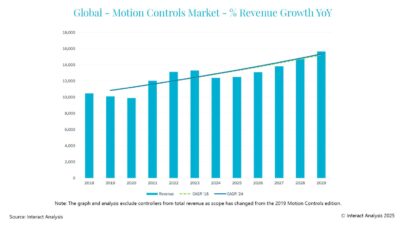I/O modules are applied most often as a slot in a PLC system or as distributed I/O systems; slot PLC connections saw the largest growth. Top five connecting communications are Ethernet, 4-20 mA, Modbus RS-485, DeviceNet, and wireless protocols. And, overall spending in the next 12 months will equal or top this year's spending for a whopping 94% of respondents to a recent Control Engineering sub...
I/O modules are applied most often as a slot in a PLC system or as distributed I/O systems; slot PLC connections saw the largest growth. Top five connecting communications are Ethernet, 4-20 mA, Modbus RS-485, DeviceNet, and wireless protocols. And, overall spending in the next 12 months will equal or top this year’s spending for a whopping 94% of respondents to a recent Control Engineering subscriber-survey.
To better understand subscribers’ I/O-modules’ applications and needs, Control Engineering worked with Reed Corporate Research on surveys for February 2006 and, previously, for December 2004. Mix of respondents differs, as do responses for the two surveys.
Among February 2006 study respondents—those specifying, recommending, and/or buying I/O modules—74% do so for in-plant requirements, and 46% buy for OEM needs. December 2004 saw 81% doing so for in-plant requirements, while 41% bought for OEM needs.
In 2006, some 37% of respondents primarily use I/O devices for both continuous and batch processing, while 16% cite continuous processing only; 28% discrete products, 13% utility services, 2% batch only, and 4% other. In 2004, some 45% of respondents primarily used I/O modules for continuous and batch processing, while 23% cited continuous processing only; 16% discrete products, 7% utility services, 5% batch only, and 4% other.
Types of modules
In 2006, discrete and analog input and discrete output represent the top tier of I/O modules used (over 90%) and will continue to represent the top tier of those used in the coming year.
In 2004, analog input, discrete input, network interface, discrete output, and analog output represented the top tier of I/O modules used (over 90%) and also are expected to remain the most used.
Endpoints of highest use for various modules (about 95%) and lowest use (about 50%) remained about the same as in 2004 and 2006. Within the high and low, few shifted more than 10 percentage points. PID went from 86% in 2004 to 74% in 2006. In 2004, loop control went from 79% in 2004 to 68% in 2006. Blocks with network connections and blocks with on-board intelligence increased slightly from 2004 to 2006.
Applications for I/O modules
In 2006, 81% respondents apply I/O modules within PLC systems; 59% slot in PLC; 51% distributed I/O systems; 46% DIN-rail mounted from PLC control supplier; 35% PC-based systems; 25% DCS systems; 22% DIN-rail mounted from supplier different from controller; 20% network gateway; 10% programmable automation controllers (PACs); 14% single point; 9% IP67 block style; 7% IP67 modular style; and 2% other.
Largest changes in 2006 from 2004 were 12 percentage points more for slot in PLCs in 2006; 9 percentage points less for PC-based systems. Temper that decrease, though, with introduction of PACs, a new choice in the 2006 survey, which may account for the decline (PACs include PC logic with PLC-like ruggedness).
Some newer I/O technologies allow application flexibility, as any points to be used as input or output, suggests Thomas Trombley, Rockwell Automation ArmorBlock I/O product manager, easing configuration to suit any control application.
Communications methods
In 2004 and 2006, Ethernet and 4-20 mA dominate current and future communications, both over 70%. Next closest was DeviceNet use at 59% in 2004; 43% in 2006.
The 2006 survey added questions on wireless, Ethernet, and other protocols. In 2006, networks used, highest to lowest, are Ethernet, 4-20 mA, Modbus RS-485, DeviceNet, wireless protocols, ControlNet, other proprietary, Profibus-DP, HART, CANopen, other, FOUNDATION fieldbus, Interbus, LonWorks, Optomux, and Seriplex.
Helge Hornis, intelligent systems manager, Pepperl+Fuchs (P+F), would add safety networks to the list, which he sees used significantly, especially in factory automation.
Robert Bristow, product manager for Honeywell, observes a ‘significant increase in the use of FOUNDATION fieldbus for process signals. Lately, significant portions of some jobs use that protocol, Bristow says, a trend he expects to continue.
Ethernet protocols, wireless
Among those using Ethernet protocols with I/O modules, highest to lowest, are TCP/IP, EtherNet/IP, Modbus/TCP, UDP/IP, FOUNDATION fieldbus HSE, Profinet, SERCOS III, Ethernet-Powerlink, EtherCat, other, and OptoMMP. Among leading protocols, TCP/IP at 80% and EtherNet/IP at 78%, were significantly ahead of Modbus/TCP 38% and UDP/IP 28%.
Opto 22 suggests that Ethernet is far and away the feature/technology/communications medium of greatest interest. They have developed boards to swap with 20-year-old I/O systems to make them Ethernet enabled, for easier information transfer to business applications. Opto 22 calls Ethernet the prevailing plant-floor communications technology. Senior application engineer for Opto 22, Tom Edwards, says, ‘Right now, Ethernet accounts for about 50% of the product we sell. By this time next year, we wouldn’t be surprised if that figure grew by 10% to 20%.’
Many reasons for Ethernet preferences, according to Bill Black, controllers product manager, GE Fanuc Automation, include ease of installation, hardware cost (off-the-shelf switches and hubs), and familiarity with the technology.
That doesn’t mean everything is located at the point of measurement or actuation, Black cautions. ‘Despite the wide range of granular I/O [modules] designed to allow the user to distribute control, the trend is still to maintain half of the I/O connections in the control cabinet…. even though there has been a flood of DIN I/O modules, it is still expensive on a per point basis, and networking is still perceived as complex,’ Black says.
Jeff Payne, product manager, PLC, I/O & PC controls, AutomationDirect, says communications is ‘possibly the greatest change in the PLC market over the past five years,’ revolutionizing how PLCs are programmed and relay data with other PLCs and with PCs for HMI, SCADA, or DCS applications. ‘Communications consistently ranks in the top three decision-making characteristics of PLC and I/O products. While serial communications are still very popular, reliable, and inexpensive, Ethernet is fast becoming the communications medium of choice,’ Payne says, because of network speed, ease of wiring, and availability of off-the-shelf networking components like switches and hubs.
Top six wireless protocols (used or plan to use) are 802.11 (any mention) 17%, Ethernet (any mention) 8%, Bluetooth 5%, proprietary 5%, WiFi (unspecified) 5%, and ZigBee 5%. Six others were mentioned. Indecision leads for use of wireless with I/O modules at 28% for ‘don’t know/haven’t decided/evaluating,’ followed closely by 27% for other.
Purchasing
Among 2006 respondents, an average of 155 I/O modules were purchased during the past 12 months. Average spending per respondent on I/O modules in the past year was $111,737.
Hornis, P+F, says process automation use has influenced these purchasing trends. ‘A large number of factory automation applications use considerably less than the quoted 155 modules. Secondly, the average purchase price ($720) is very high,’ he suggests, influenced by process automation responses.
Purchases of I/O modules will increase in the next 12 months among 47% of 2006 respondents; 47% expect to purchase about the same. Only 6% predict a lower demand. Slightly less expected an increase in I/O module purchase in 2004 at 43% in the next 12 months; 53% then expected to purchase about the same. Only 4% predicted a lower demand.
End-users increasingly want an ‘OEM to define the system, hand it to them, and guarantee the performance,’ says Joe Benedetto, senior product manager, Schneider Electric. Also, ‘increasingly we see that end-users don’t need to buy the PLC’s bigger, more expensive I/O system. So if they only need 50 or 100 I/O points in one location, they buy distributed I/O because it is less costly.’ A lot of distributed I/O modules are being used with PLCs because it costs less than larger I/O systems and requires less panel space, Benedetto says.
Leading features among those purchasing in 2006 were technical support, availability of stock, communication capabilities, and ease of use. Network capabilities rounded out the top five and cost was just below that (see graphic).
Responses to I/O module product features show the critical nature of support, Black, GE Fanuc, says. ‘Users demand easy installation, commission and trouble-shooting, and support.’ Support rates highest, suggests Benedetto of Schneider Electric, since ‘a lot of end-users don’t have the in-house technical support staff they once had, so they rely on manufacturers to provide that support. Capability to support a product is just as important as the performance of that product, in many cases.’ Stock availability is important because ‘downtime is horribly expensive…. tens of thousands of dollars per minute, depending on the application. But panel control builders and other OEMs don’t want to keep an inventory because it costs money unnecessarily. OEMs expect manufacturers to have products available immediately.’
I/O module products
For other manufacturers, visit www.cesuppliersearch.com ; for system integrators, go to www.controleng.com/integrators ; for more on these products, see the Web sites below.
Flexibility, easier termination for I/O line
Rockwell Automation added high- density, 12-point analog modules, HART analog modules, and D-Shell connector I/O bases with optional expansion boards to the Allen-Bradley Flex I/O product line. They are said to provide increased flexibility, greater communication capabilities, and the opportunity to fit more I/O terminations in the same space. The 12-point analog modules have higher resolution (16-bit) and filtered inputs for better noise resistance and can drive larger loads that require 12 V. Flex I/O modules come in input (1794-IE12), output (1794-OE12), and combination input/output (1794-IE8XOE12). New eight-point HART analog I/O modules (1794-IE8H HART and -OE8H HART) allow Flex I/O to communicate with HART-enabled smart field devices. These can be used on ControlNet or EtherNet/IP networks and can be connected to HART field devices, HART handheld programming terminals, Rockwell Automation controllers, and field device tool (FDT)-compatible software. Flex I/O bases with new D-Shell connectors and optional expansion boards speed connection and termination. www.rockwellautomation.com Rockwell Automation
Cabinetless digital I/O block
Siemens Energy & Automation Simatic ET 200eco cost-efficient digital block I/O enables cabinetless installation with IP67 protection at the site of the process. Eco stands for ‘easy connection, easy commissioning and economical.’ M12 and Ecofast connection systems are available. Features include compact, rugged, easy-care housing, hot swapping without interrupting the power supply or the bus line, and variable and flexible connection blocks. www.sea.siemens.com Siemens Energy & Automation
High-speed counter module
GE Fanuc’s new High Speed Counter for the RX3i allows configuration and control of eight 32-bit independent counters on one module. It can be configured to support Type A, B, C, D, E, and Z counters at a rate up to 1.5 MHz clock rate. It can be configured to turn on any of 14 on-board outputs that can be controlled independently of the PLC; any of the 8 inputs can generate an interrupt back to the controller. It also is said to provide extensive diagnostics and be ideal for turbine control, meter proving, velocity measurement, material handling, motion control, and process control. PACSystems RX3i includes serial backplane for easy migration of existing Series 90-30 I/O modules. www.gefanuc.com GE Fanuc
3 new communications modules
AutomationDirect’s DL05/DL06 micro PLC family has three new communications modules. D0-DCM module ($129) adds two serial ports, which support Modbus, Modbus RTU, DirectNet, and K-Sequence to any DL05 or DL06 PLC, using RS-232 or RS-422/485 data interfaces, up to 115.2 Kbps. F0-CP128 CoProcessor module ($185) offers three serial communication ports, configurable using Basic programming capability. It has 100 MHz clock speed, RS-232 or RS-485 data interface options, and communication rates up to 512 Kbps. With auto-detection technology, the H0-ECOM100 Ethernet communication module ($199) implements master/slave communication at 10 or 100 Mbit data rates. It supports IP and IPX. Modbus TCP/IP Client/Server protocol allows the PLC to serve as a client (master) or as a server (slave). www.automationdirect.com AutomationDirect
I/O modules fit any controller
For OEMs or end-users who want to create modular machines and control architectures and allow I/O points to be distributed on machine modules without regard to type of controller, Schneider Electric has extended its Telemecanique Advantys STB distributed I/O system with a new set of modules. The expanded line provides a lower feature set system at a lower cost per point. It also enables OEMs to optimize a machine’s distributed I/O connections with a modular system that makes it possible for one fieldbus node to distribute connections across an entire machine or process. www.telemecanique.com Schneider Electric
Ethernet I/O embeds switch
A new Phoenix Contact Inline block style I/O module with a built-in Ethernet switch reduces total installed cost and size up to 50% when compared to solutions combining a switch and I/O module individually. ILB ETH 24 DI 16 DIO 16-2TX is the latest addition to the Inline Block I/O family. It has two unmanaged 10/100 Mbps RJ45 ports, 16 digital inputs, and 16 channels that can be used for inputs or outputs. Two RJ45 ports can connect to an Ethernet network and a separate Ethernet device. Built-in Web server enables simple remote configuration of Ethernet ports and monitoring of module diagnostics and I/O status. It supports Modbus TCP (up to 8 connections), OPC, and XML polling (read access only). SNMP and BootP services enable remote configuration and diagnostic messaging. Compact single module design installs easily in distributed control panels or control cabinet doors. www.phoenixcon.com Phoenix Contact
Digital I/O devices
NI PCI-6521, PXI-6521, and PCI-6520 industrial digital I/O devices deliver eight www.ni.com National Instruments
I/O modules for remote sensors
Omron Electronics’ Remote Sensor I/O (SRT1-ND08S) has 8-point input, 8-point output, mixed 4-in /4-out modules. The modules simplify connection of 2- and 3-wire sensors to CompoBus/S network with easy-to-wire insulation displacement. They feature remote teaching function, diagnostics, and bank selection functions that can be set and monitored by a PLC, with DIN-rail and screw mounting. www.omron.com/oei Omron Electronics
Multiple modules for I/O series
Honeywell’s Experion PKS Series C I/O and controller products provide process I/O options with reduced footprint, easier installation and maintenance, and longer life. Benefits extend to multiple modules: Series C C300 Controller, Fieldbus Interface Module, Control Firewall, and HART analog modules. ‘Designed-vertical,’ removable two-tier wiring terminations provide easily accessible wiring to reduce installation and maintenance costs. They have high-density modular construction with slanted form factor to distribute heat more uniformly, extend module life, and reduce cooling costs. Redundancy provides high availability and longer lifecycle. www.honeywell.com Honeywell
I/O upgrade preserves field wires
FlexConnect Solutions for Provox Discrete Control I/O connect to the Provox Series 20 wiring termination panel. This allows access to I/O connections without touching existing field wiring. Inputs and outputs are automatically marshaled to the appropriate I/O connections in DeltaV, which speeds startup by reducing instrument checkout time. www.easydeltav.com Emerson Process Management
Isolated analog modules
Opto 22 introduced four new isolated analog modules: Snap-Aiarms-i, for ac/dc current measurement applications; Snap-Aivrms-i, for ac/dc voltage measurement; Snap-Aima2-i, for monitoring very low currents; and Snap-AOA-23-iSRC, with built-in, isolated loop sourcing to output current values to industrial devices. Modules electrically isolate connected field devices, eliminating possibility of damage from differing operating voltages for the connected devices. They protect against damage to devices that may share a module with an overloaded or otherwise malfunctioning device. Built-in, isolated loop sourcing on Snap-AOA-23-iSRC can significantly reduce troublesome ground loops when installing 4-20 mA instrumentation. www.opto22.com Opto 22
Flexible digital I/O module
Red Lion’s Modular Controller has become more flexible with release of the CSDIO14 Digital Module, which offers eight digital inputs and six outputs, for applications that require simple I/O or logic functionality. It can provide discrete inputs and outputs for PC and HMI-based applications. Through use of the graphical logic-engine, the CSDIO provides control for applications that don’t require a PLC. With built-in PLC and Ethernet protocols, it takes only minutes to configure the largest, most complex PID, data-acquisition, or I/O systems, company says. www.redlion.net Red Lion
AS-i gateways, scanners connect to A-B PLCs
Pepperl+Fuchs’ AS-Interface Gateways and Scanners connect with and support Allen-Bradley MicroLogix, ControlLogix, PLC 5, SLC500, and CompactLogix platforms. PLC powered, they offer removable-terminal connections and easy RS-232, PLC, or push-button programming. Advanced LED or LCD displays provide easy visual indication of network status and advanced diagnostics for easy troubleshooting. VBM-CLX-DM AS-i scanner module supports the ControlLogix PLC platform and has fast, easy commissioning via two pushbuttons, LEDs, and an LCD display. I/O data and status information are mapped in the PLC processor’s I/O data. Analog Profile 7.3 is built in as standard; extended addressing is possible. www.am.pepperl-fuchs.com Pepperl+Fuchs
Machine-mounted I/O can integrate pneumatics
Beckhoff Automation IE2808 IP-Link Extension Box offers 16 digital 24 V dc outputs at a low price per channel, designed as an extremely compact, IP67-rated I/O and pneumatic module for direct mounting on machines. A 25-pin D-Sub connector ties to outputs; each channel is short circuit-proof and offers diagnostic capabilities. It offers direct connections to valve terminals in wet, dusty, and other demanding industrial environments; 16 digital outputs for connecting digital actuators are provided on 30 x 126 mm mounting. It has 0.5 A at 24 V dc for each channel, with a total current of 4 A for all connected outputs. It connects at the control level via I/O Coupler Box modules with Profibus, DeviceNet, CANopen, or Ethernet. Other modules for common signal types are available. www.beckhoffautomation.com Beckhoff Automation
“Product Focus: I/O modules on a continuous improvement path ”




